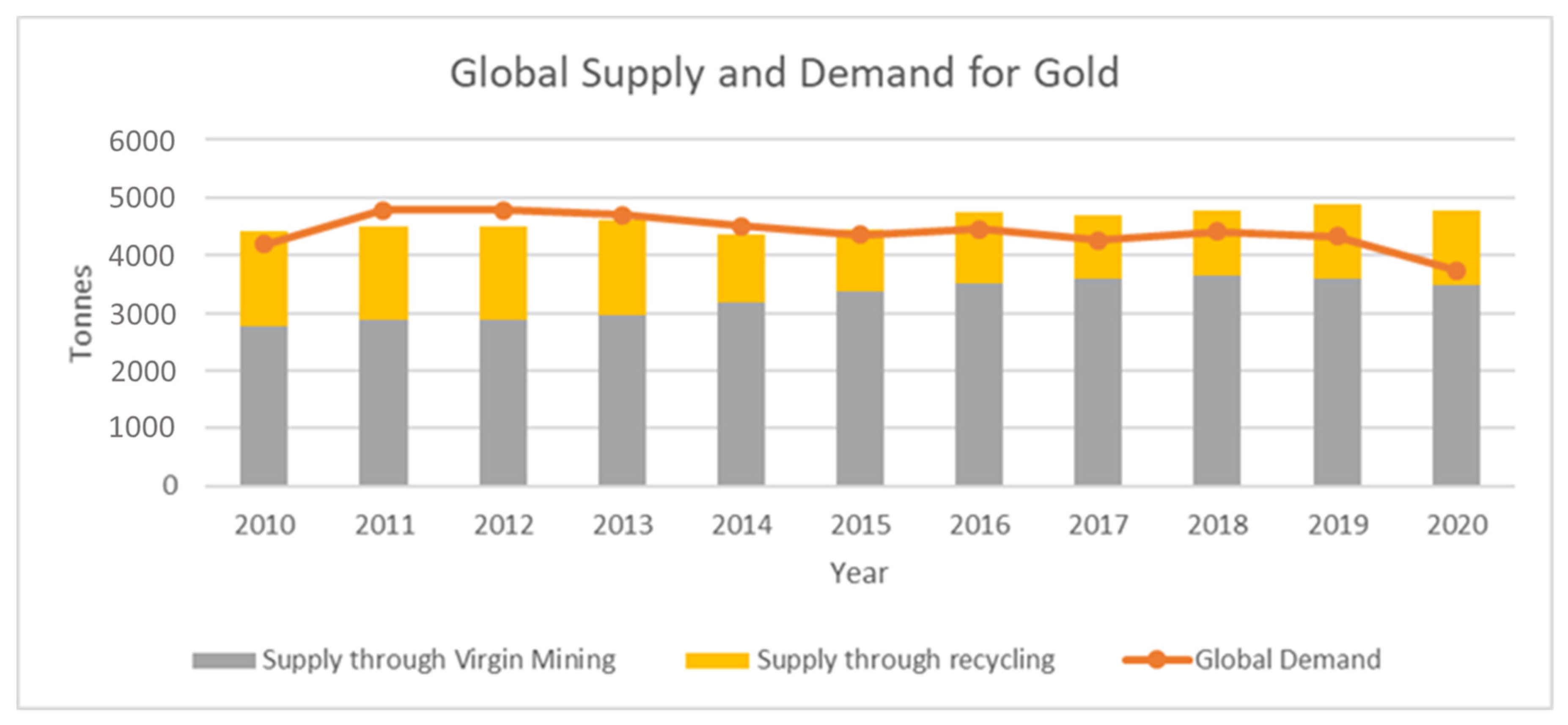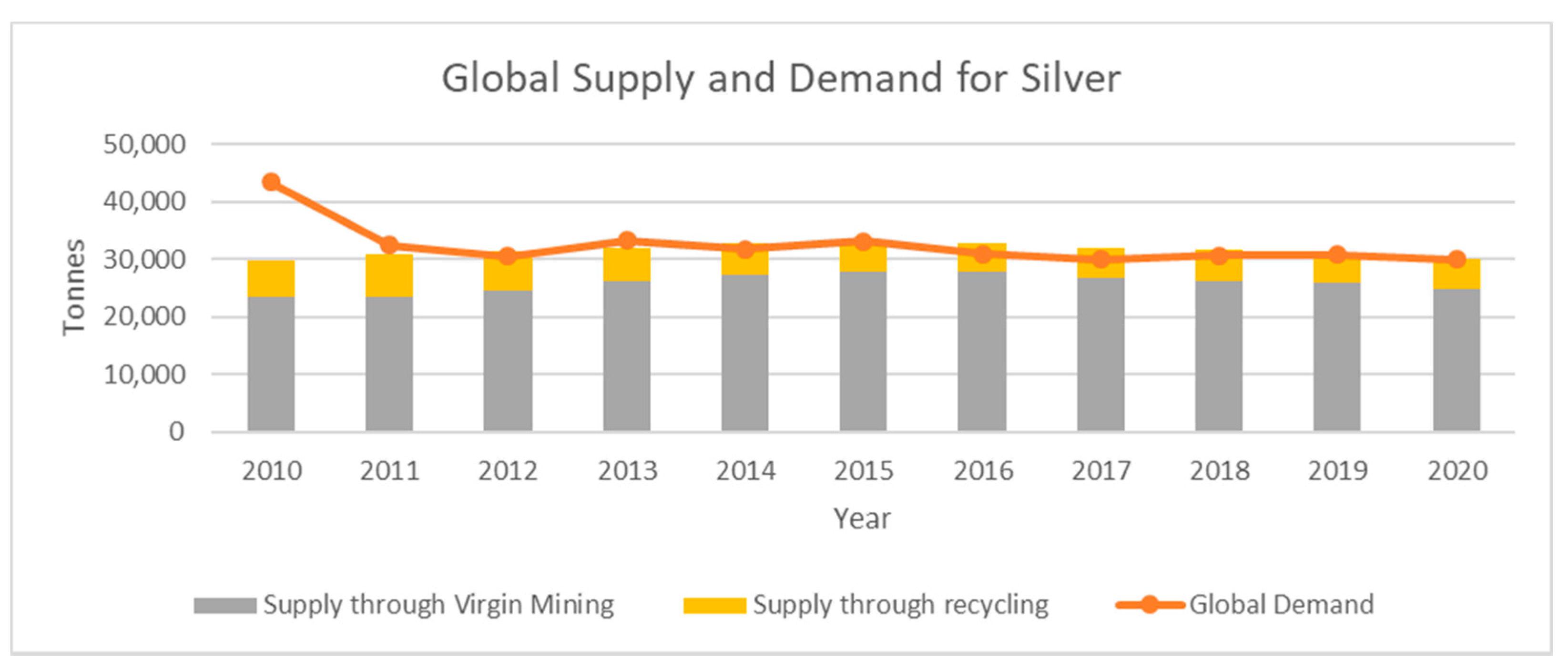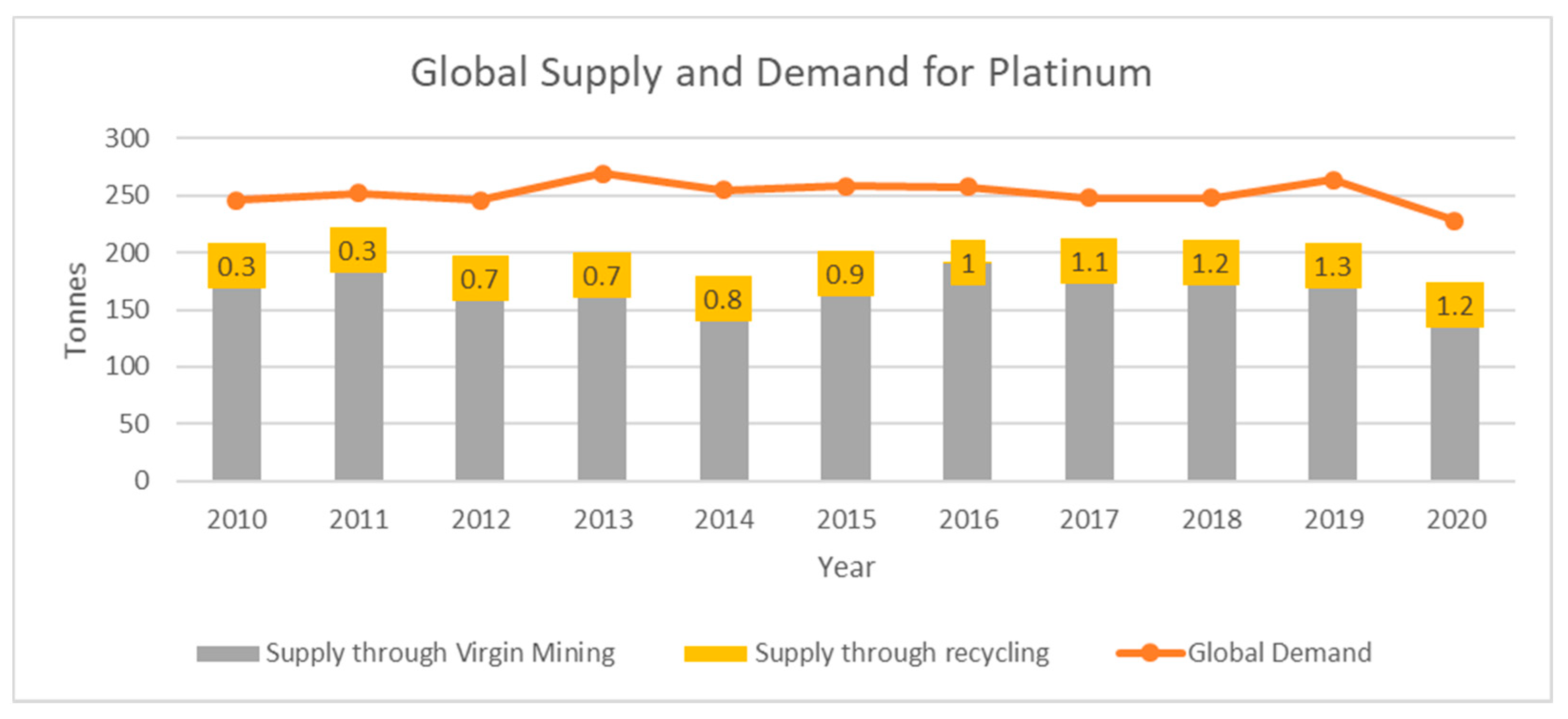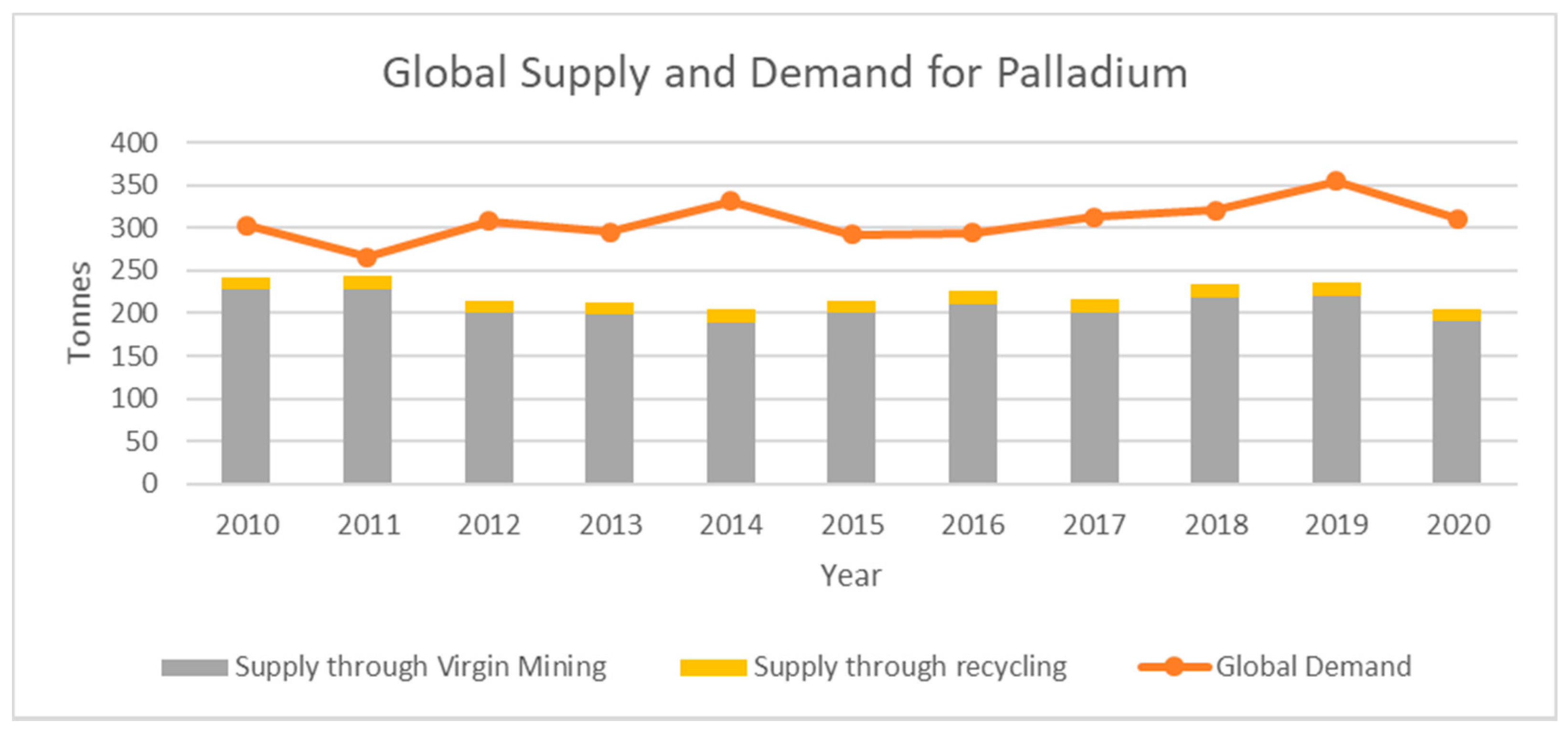A Review on Global E-Waste Management: Urban Mining towards a Sustainable Future and Circular Economy
Abstract
:1. Introduction
2. Global E-Waste Statistics and Value
3. The World Health Organization (WHO) Report 2021: Children and Digital Dumpsites
4. Natural Resources and Depletion Rate
5. International Conventions, Regulations and Laws
6. The Basel Convention
7. Achieving UN Sustainable Development Goals (SDGs) and E-Waste
- SDG 3: Good health and well-being,
- SDG 6: Clean waste and sanitation,
- SDG 8: Decent work and economic growth,
- SDG 11: Sustainable cities and communities
- SDG 12: Responsible consumption and production and
- SDG 14: Life below water
8. E-Waste Legislations across the Globe
8.1. Asia
8.2. The Americas
8.3. Europe
8.4. Africa
8.5. Oceania
9. Extended Producer Responsibility (EPR) and Producer Responsibility Schemes across the Globe
- 1.
- Product take-back: This tool assigns responsibility for product end-of-life management to manufacturers or merchants. This is frequently accomplished by setting collecting and recycling goals for a product. Producers may choose to do an obligatory or voluntary takeback. Producers might also meet their goals by offering consumers incentives for returning unwanted products to a reputable merchant.
- 2.
- Economic and market-based instruments provide a monetary incentive for the implementation of EPR policies. They are available in four different forms:
- Deposit-refund: At the time of purchase, the buyer must pay a deposit, which is partially or totally recovered when the goods is returned to the producer/retailer at a defined location.
- Advanced disposal fees (ADF): Consumers are paid a price at the time of purchase for specific items depending on expected collection and treatment expenses. The charge is collected by either governmental or private bodies and used to fund the post-consumer treatment of the items in question. Consumers may be reimbursed for unused costs.
- Material tax: This is a tax paid on manufacturers who use virgin materials, difficult-to-recycle materials, or hazardous materials, in order to encourage them to use secondary (recycled) or less harmful resources. The tax should ideally be set at a level that covers the treatment expenses. Post-consumer items are collected, sorted and treated with the help of the tax.
- Upstream combination tax/subsidy (UCTS): This is a tax that is levied on manufacturers and then used to finance garbage treatment. It also offers businesses with incentives to change the design and materials of their products, as well as a finance plan to encourage recycling and treatment.
- 3.
- Regulations and performance standards imposed on producers can compel them to employ a minimum number of recycled materials, which can stimulate the return and recycling of end-of-life items. When combined with a fee, such rules can help to improve incentives for product redesign. The industries themselves might implement performance criteria that are either mandated or voluntary.
- 4.
- Information-based instruments are meant to raise public knowledge of EPR programs and thereby indirectly support them. Labeling items and components, communicating with customers about producer responsibility and waste separation and notifying recyclers about the materials used in products are all examples of possible measures [14,24,25,26] (Rashmi and Seeram 2020).
10. Health Hazards and Environmental Impacts
- cheap labor,
- illiteracy rate,
- lack of policy enforcement,
- lack of statistics on the amount of E-waste generated,
- lack of formal infrastructure,
- lack of awareness among stakeholders,
- inadequate individual and social responsibilities,
- dominance of informal sector.
11. Urban Mining V/S Virgin Mining
12. Entrepreneurship and Expertise
13. Discussion on the Global Challenges and Opportunities in a Structured E-Waste Management
- Legal Framework: The gaps and solutions with respect to the current policies are explained below.
- Cheaper than virgin mining,
- More sustainable and effective,
- Help preserve natural resources,
- No harm to the environment as it takes place in a controlled system,
- Health and safety of women and children are protected,
- Helps achieve a decarbonized circular economy.
- 2.
- Benchmark Technology: Although E-waste legislation is the main path for the transition towards a circular economy, state of the art infrastructure and benchmark technologies also play an important role. The resources, hazards and impacts for E-waste generated are the same across the globe, but each country has a different processing system. There is an immediate need for the international leaders to review the global best technological practices carried out to arrive at a benchmark technology for each of the processing cycles of E-waste [49,50,51]. Innovation may be the key to come up with indigenous technology for recycling, re-use, repair, refurbishment and component harvesting to extend the life spans of the products and components and to optimize and increase the outputs of E-waste processing plants. This would also help us achieve transparency and avoid illegal methods of handling E-waste.
- 3.
- Implementation of EPR: Even when the chemistry of the product remains the same and producers use the same resources, the EPR policy differs greatly between OECD and non-OECD countries, thus creating complex issues in E-waste management. Stakeholders are not aware of the roles and responsibilities because of the confusion in policies varying across the globe. To establish a legal and environment-friendly sound management of E-waste, stringent adoption of a mandated universal EPR law across the globe is critical. Implementation of a common law will make sure generators and manufacturers are aware of their responsibilities and will act accordingly without conflicts.
- 4.
- Green policies such as Green Product Identification should be enforced mandatorily, where the producers are responsible for identifying the chemistry of their product and making sure that each component manufactured can be harvested at their end-of-life. Clearly, enforcement of EPR is very essential in order to drive the stakeholders towards responsible design of products, production and processing of the recycled E-waste. Such practices can only be fruitful when the government supports and encourages the formal system of E-waste management by facilitating their needs through financial, technological or expert support.
- 5.
- Consumer Behavior: While manufacturers and generators need to act responsibly, there is a need for consumers to also play a role in disposing their E-waste responsibly. Regulating the manufacturers to give comprehensive information about each product to the consumers containing information about the composition, hazards of improper disposal, practices of re-use, repair and refurbishment, life span of the product, etc., can bring a significant change in the way consumers view their contributions to a greener environment. In addition, awareness activities need to be conducted for consumers on the effects of illegal dumping of E-waste.
- 6.
- Transformation of the Informal Sector: Unsustainable methods of handling E-waste have created a problem the size of a planet. Women and children from the illiterate sections of society are used for dismantling E-waste. Processes such as manual stripping of cables, lack of safety gear, open incineration and acid leaching have led to various diseases and caused irreparable damage to the environment. Due to a significant dominance of the informal sector handling E-waste (Figure 4), it is a grave task to educate and transform them about the hazards caused due to their illegal and unorthodox methods of processing the E-waste. Formalizing them would solve 90% of the problems caused to the environment by E-waste and would be easy to trace and maintain transparency on the amount of E-waste generated and processed.
14. Conclusions
Author Contributions
Funding
Institutional Review Board Statement
Informed Consent Statement
Conflicts of Interest
References
- WEEE Forum. Report on International E-Waste Day 2021. Available online: https://weee-forum.org/iewd-about/ (accessed on 25 October 2021).
- Kumar, A.; Holuszko, M.; Espinosab, D.C.R. E-waste: An overview on generation, collection, legislation and recycling practices. Resour. Conserv. Recycl. 2017, 122, 32–42. [Google Scholar] [CrossRef]
- Grant, K.; Goldizen, F.C.; Sly, P.D.; Brune, M.-N.; Neira, M.; Berg, M.V.D.; Norman, R. Health consequences of exposure to E-waste: A systematic review. Lancet Glob. Heath 2013, 1, e350–e361. [Google Scholar] [CrossRef] [Green Version]
- Mihai, F.-C.; Gnoni, M.-G.; Meidiana, C.; Ezeah, C.; Elia, V. Chapter 1—Waste Electrical and Electronic Equipment (WEEE): Flows, Quantities, and Management—A Global Scenario. In Electronic Waste Management and Treatment Technology; Prasad, M.N.V., Vithanage, M., Eds.; Butterworth-Heinemann: Kidlington, UK, 2019; pp. 1–34. [Google Scholar]
- United Nations Children’s Fund (UNICEF). Policy 2020: Protection of Children during the COVID-19 Pandemic. Available online: https://www.unicef.org/documents/protection-children-during-covid-19-pandemic-children-and-alternative-care (accessed on 25 October 2021).
- The United Nations Global E-Waste Monitor—2020, a Collaborative Product of Global E-Waste Statistics Partnership (GESP), the International Telecommunication Union (ITU), and the International Solid Waste Association (ISWA). Available online: http://E-wastemonitor.info/ (accessed on 26 October 2021).
- Baldé, C.P.; van den Brink, S.; Forti, V.; van der Schalk, A.; Hopstaken, F. The Dutch WEEE Flows 2020. “What happened between 2010 and 2018”; United Nations University (UNU)/United Nations Institute for Training and Research (UNITAR): Tokyo, Japan, 2020. [Google Scholar]
- Perkins, D.N.; Drisse, M.B.; Nxele, T.; Sly, P.D. E-waste: A global hazard. Ann. Glob. Health 2014, 80, 286–295. [Google Scholar] [CrossRef] [PubMed]
- The World Health Organization (WHO) Report 2021: Children and Digital Dumpsites. Available online: https://www.who.int/publications-detail-redirect/9789240023901 (accessed on 28 October 2021).
- Secretariat of the UN Environment Management Group (EMG). “A New Circular Vision for Electronics: Time for a Global Reboot”. Geneva, Switzerland: World Economic Forum (WEF). 2019. Available online: https://www3.weforum.org/docs/WEF_A_New_Circular_Vision_for_Electronics.pdf (accessed on 29 October 2021).
- UN Sustainable Development Agenda 2021: Sustainable Development Goals (SDGs). Available online: https://www.in.undp.org/content/india/en/home/sustainable-development-goals.html (accessed on 28 October 2021).
- Hackett, D.P. Assessment of the Basel Convention on the control of Transboundary Movements of Hazardous Wastes and Their Disposal. Am. Univ. J. Int. Law Pol. 1989, 5, 31. [Google Scholar]
- United Nations Environment Programme (UNEP). Report on the Basel Convention on the Control of Transboundary Movements of Hazardous Wastes. Available online: http://www.basel.int/TheConvention/Overview/tabid/1271/Default.aspx (accessed on 26 October 2021).
- Patil, R.A.; Ramakrishna, S. A comprehensive analysis of e-waste legislation worldwide. Environ. Sci. Pollut. Res. 2020, 27, 14412–14431. [Google Scholar] [CrossRef]
- E-Waste. Available online: https://www.sprep.org/pacwaste/E-waste (accessed on 30 October 2021).
- E-Waste Country Assessments. Available online: www.sprep.org/attachments/Publications/WMPC/Summary_Rep_PacWaste_TAP_E-waste_Country_Assess.pdf (accessed on 25 October 2021).
- Alghazo, J.; Ouda, O.; Elhassan, A. E-waste environmental and information security threat: GCC countries vulnerabilities. Euro-Mediterr. J. Environ. Integr. 2018, 3, 5–9. [Google Scholar] [CrossRef]
- Baldé, C.P.; Forti, V.; Gray, V.; Kuehr, R.; Stegmann, P. “The Global E-Waste Monitor 2017”. Edited by United Nations University (UNU), International Telecommunication Union (ITU), and International Solid Waste Association (ISWA). 2017. Available online: https://collections.unu.edu/eserv/UNU:6341/Global-E-waste_Monitor_2017__electronic_single_pages_.pdf (accessed on 29 October 2021).
- Jupille, J. The European Union and international outcomes. Int. Organ. 1999, 53, 409–425. [Google Scholar] [CrossRef]
- European Commission (2012/95/EU). Restriction of Hazardous Substances in Electrical and Electronic Equipment (RoHS). Available online: https://ec.europa.eu/environment/topics/waste-and-recycling/rohs-directive_en (accessed on 29 October 2021).
- European Community Directive 2012/19/EU. Waste Electrical and Electronic Equipment Directive (WEEE Directive). Available online: https://eur-lex.europa.eu/legal-content/EN/TXT/PDF/?uri=CELEX:32012L0019&from=EN (accessed on 29 October 2021).
- Cucchiella, F.; D’Adamo, I.; Koh, S.L.; Rosa, P. A profitability assessment of European recycling processes treating printed circuit boards from waste electrical and electronic equipments. Renew. Sustain. Energy Rev. 2016, 64, 749–760. [Google Scholar] [CrossRef] [Green Version]
- Patil, R.A.; Ramakrishna, S. A Comprehensive Analysis of E-Waste Legislation Worldwide; Springer: Berlin, Germany, 2020; pp. 5–10. [Google Scholar]
- Zeng, X.; Yang, C.; Chaing, J.F.; Li, J. Innovating E-waste management: From macroscopic to microscopic scales. Sci. Total Environ. 2017, 575, 1–5. [Google Scholar] [CrossRef]
- Zhang, L.; Yuan, Z.; Bi, J.; Huang, L. Estimating future generation of obsolete household appliances in China. Waste Manag. Res. 2012, 30, 1160–1168. [Google Scholar] [CrossRef]
- Krumay, B. Chapter Privacy Technologies and Policy. In The E-Waste-Privacy Challenge: A Grounded Theory Approach; Series Lecture Notes in Computer Science (LNCS); Springer: Wien, Austria, 2016; pp. 48–68. [Google Scholar]
- Arain, A.; Neitzel, R.L. A Review of Biomarkers Used for Assessing Human Exposure to Metals from E-waste. Int. J. Environ. Res. Publ. Health 2019, 16, 15–16. [Google Scholar] [CrossRef] [PubMed] [Green Version]
- Roychowdhury, P.; Alghazo, J.M.; Debnath, B.; Chatterjee, S.; Ouda, O.K.M. Security threat analysis and prevention techniques in electronic waste. In Waste Management and Resource Efficiency; Springer: Singapore, 2018. [Google Scholar] [CrossRef]
- Sankhla, M.S.; Nandan, M.; Mohril, S.; Singh, G.P.; Chaturvedi, B.; Kumar, R.; Kumari, M. Effect of Electronic waste on Environmental & Human health—A Review. IOSR J. Environ. Sci. Toxicol. Food Technol. 2016, 10, 98–104. [Google Scholar]
- Tiller, K. Heavy Metals in Soils and Their Environmental Significance. In Advances in Soil Science; Springer: Berlin/Heidelberg, Germany, 1989; pp. 113–142. [Google Scholar]
- Pinto, V.N. E-waste hazard: The impending challenge. Indian J. Occup. Environ. Med. 2008, 12, 65–70. [Google Scholar] [CrossRef]
- Ramesh Babu, B.; Parande, A.K.; Ahmed Basha, C. Electrical and electronic waste: A global environmental problem. Waste Manag. Res. 2007, 25, 307–318. [Google Scholar] [CrossRef]
- Kiddee, P.; Naidu, R.; Wong, M.H.; Hearn, L.; Müller, J.F. Field investigation of the quality of fresh and aged leachates from selected landfills receiving E-waste in an arid climate. Waste Manag. 2014, 34, 2292–2304. [Google Scholar] [CrossRef] [PubMed]
- Gangwar, C.; Choudhari, R.; Chauhan, A.; Kumar, A.; Singh, A.; Tripathi, A. Assessment of air pollution caused by illegal E-waste burning to evaluate the human health risk. Environ. Int. 2019, 125, 191–199. [Google Scholar] [CrossRef] [PubMed]
- Rautela, R.; Arya, S.; Vishwakarma, S.; Lee, J.; Kim, K.-H.; Kumar, S. E-waste management and its effects on the environment and human health. Sci. Total Environ. 2021, 773, 145623. [Google Scholar] [CrossRef] [PubMed]
- Ramanayaka, S.; Keerthanan, S.; Vithanage, M. Urban Mining of E-Waste: Treasure Hunting for Precious Nanometals. In Handbook of Electronic Waste Management; Prasad, M.N.V., Vithanage, M., Borthakur, A., Eds.; Butterworth-Heinemann: Kidlington, UK, 2019; pp. 19–54. [Google Scholar]
- Ahirwar, R.; Tripathi, A.K. E-waste management: A review of recycling process, environmental and occupational health hazards and potential solutions. Environ. Nanotechnol. Monit. Manag. 2021, 15, 100409. [Google Scholar] [CrossRef]
- Kiddee, P.; Naidu, R.; Wong, M.H. Electronic waste management approaches: An overview. Waste Manag. 2013, 33, 1237–1250. [Google Scholar] [CrossRef] [PubMed]
- Step: Solving the E-Waste Problem. Available online: https://www.step-initiative.org/organisation-rev.html (accessed on 30 October 2021).
- Chatterjee, A.; Abraham, J. Efficient management of E-wastes. Int. J. Environ. Sci. Technol. 2016, 14, 211–222. [Google Scholar] [CrossRef]
- Harikrushnan, B.; Shreyass, G.; Hemant, G.; Pandimadevi, M. Recovery of metals from printed circuit boards(pcbs) using a combination of hydrometallurgical and biometallurgical processes. Int. J. Environ. Res. 2016, 10, 511–518. [Google Scholar]
- Pant, D.; Joshi, D.; Upreti, M.K.; Kotnala, R.K. Chemical and biological extraction of metals present in E waste: A hybridtechnology. Waste Manag. 2012, 32, 979–990. [Google Scholar] [CrossRef]
- Shagun, K.A.; Arora, A. Proposed Solution of E-waste Management. Int. J. Future Comput. Commun. 2013, 2, 490–493. [Google Scholar]
- Lundgren, K. The Global Impact of E-Waste: Addressing the Challenge; International Labour Organization: Geneva, Switzerland, 2012. [Google Scholar]
- Rene, E.R.; Sethurajan, M.; Ponnusamy, V.K.; Kumar, G.; Dung, T.N.B.; Brindhadevi, K.; Pugazhendhi, A. Electronic waste generation, recycling and resource recovery: Technological perspectives and trends. J. Hazard. Mater. 2021, 416, 125664. [Google Scholar] [CrossRef] [PubMed]
- Tanskanen, P. Management and recycling of electronic waste. Acta Mater. 2013, 61, 1001–1011. [Google Scholar] [CrossRef]
- Kaya, M. Recovery of metals and nonmetals from electronic waste by physical and chemical recycling processes. Waste Manag. 2016, 57, 64–90. [Google Scholar] [CrossRef] [PubMed]
- Hazardous Waste Including E-Waste. Available online: https://www.epa.govt.nz/industry-areas/hazardous-substances/hazardous-waste/hazardous-waste-types/ (accessed on 26 October 2021).
- Islam, A.; Ahmed, T.; Awual, M.R.; Rahman, A.; Sultana, M.; Aziz, A.A.; Monir, M.U.; Teo, S.H.; Hasan, M. Advances insustainable approaches to recover metals from E-waste—A review. J. Clean. Prod. 2020, 244, 118815. [Google Scholar] [CrossRef]
- Hong, J.; Shi, W.; Wang, Y.; Chen, W.; Li, X. Life cycle assessment of electronic waste treatment. Waste Manag. 2015, 38, 357–365. [Google Scholar] [CrossRef] [PubMed]
- Xue, M.; Xu, Z. Application of life cycle assessment on electronic waste management: A review. Environ. Manag. 2017, 59, 693–707. [Google Scholar] [CrossRef]









| Precious Metal | Quantity Available in Below-Ground Reserves (Tons) | Annual Consumption Rate (Tons) | Depletion Period (Years) | Major Regions of Source |
|---|---|---|---|---|
| Gold | 50,000 | 4400 | 11 | South Africa, USA, Indonesia |
| Silver | 503,000 | 33,000 | 15 | Peru, Australia, Poland |
| Platinum | 69,000 | 252 | 19 | South Africa, Russia, Zimbabwe |
| Copper | 870,000,000 | 28,000,000 | 31 | Chile, Mexico, USA, Indonesia |
| Region | Annual E-Waste Generation (Mt) | Percentage of E-Waste Generation (%) | E-Waste (kg/Person) |
|---|---|---|---|
| Asia | 24.9 | 46.5 | 5.6 |
| The Americas | 13.1 | 24.4 | 13.3 |
| Europe | 12 | 22.4 | 16.2 |
| Africa | 2.9 | 5.4 | 2.5 |
| Oceania | 0.7 | 1.3 | 16.1 |
| E-Waste Component | Process Followed by Informal Sectors | Potential Health Hazard | Potential Environmental Impact |
|---|---|---|---|
| Cathode Ray Tubes (CRT) | Breaking of the copper yoke, removal of copper yoke and openly discarding it in landfills |
| Leaching of heavy metals such as lead, barium and others into groundwater, as well as the release of toxic phosphorus |
| Printed Circuit Boards (PCBs) | De-soldering and separating computer chips |
| Probable emission of the exact substances in to the atmosphere |
| Dismantled PCB Processing | Open incineration of PC boards | Toxicity of tin, lead, brominated dioxin, beryllium, cadmium and mercury inhalation in employees and nearby residents | Brominated dioxins, beryllium, cadmium and mercury inhalation, as well as tin and lead pollution of the nearby environment, including surface and groundwater |
| Gold-Plated Substances and other Chips | Chemical stripping of contaminants along riverbanks with nitric and hydrochloric acid |
|
|
| Plastics from the computer and peripherals | Lower temperature melting and Shredding | Workers living in the burning operations vicinity may have been exposed to hydrocarbons, brominated dioxin and PAH. | Brominated dioxins, heavy metals and hydrocarbons emissions in to the atmosphere |
| Smelting of secondary steel, copper and precious metals | Steel or copper is recovered from waste in the furnace. | Dioxins and heavy metals may be exposed to workers | Dioxins and heavy metals are released into the environment, contaminating the air. |
| Wires | Open incineration for the recovery of copper | Workers living in the burning operations vicinity may have been exposed to brominated and chlorinated dioxin and PAH | Discharge of hydrocarbons and ashes, including PAHs, into the air, water and soil |
Publisher’s Note: MDPI stays neutral with regard to jurisdictional claims in published maps and institutional affiliations. |
© 2022 by the authors. Licensee MDPI, Basel, Switzerland. This article is an open access article distributed under the terms and conditions of the Creative Commons Attribution (CC BY) license (https://creativecommons.org/licenses/by/4.0/).
Share and Cite
Murthy, V.; Ramakrishna, S. A Review on Global E-Waste Management: Urban Mining towards a Sustainable Future and Circular Economy. Sustainability 2022, 14, 647. https://doi.org/10.3390/su14020647
Murthy V, Ramakrishna S. A Review on Global E-Waste Management: Urban Mining towards a Sustainable Future and Circular Economy. Sustainability. 2022; 14(2):647. https://doi.org/10.3390/su14020647
Chicago/Turabian StyleMurthy, Venkatesha, and Seeram Ramakrishna. 2022. "A Review on Global E-Waste Management: Urban Mining towards a Sustainable Future and Circular Economy" Sustainability 14, no. 2: 647. https://doi.org/10.3390/su14020647
APA StyleMurthy, V., & Ramakrishna, S. (2022). A Review on Global E-Waste Management: Urban Mining towards a Sustainable Future and Circular Economy. Sustainability, 14(2), 647. https://doi.org/10.3390/su14020647







